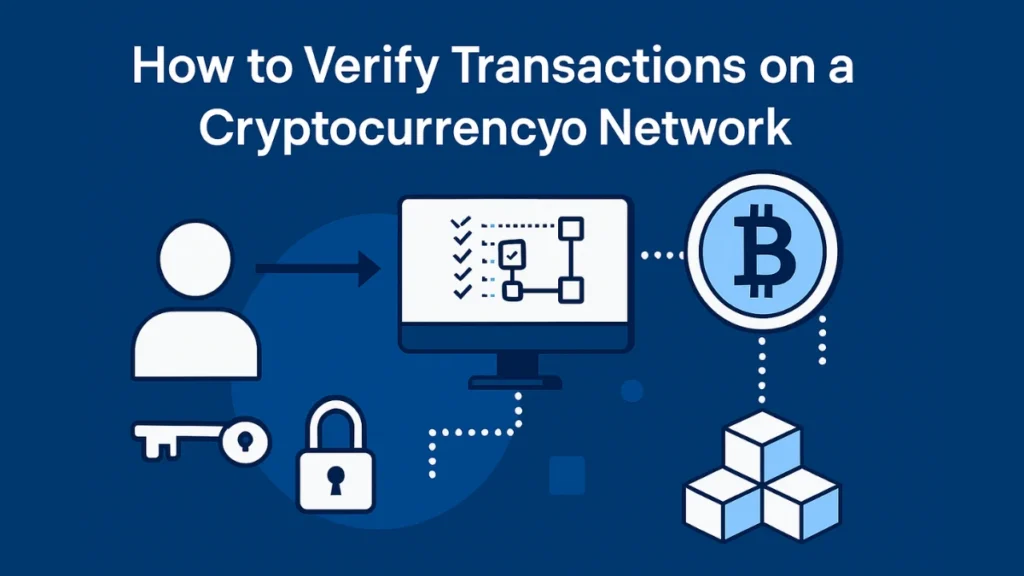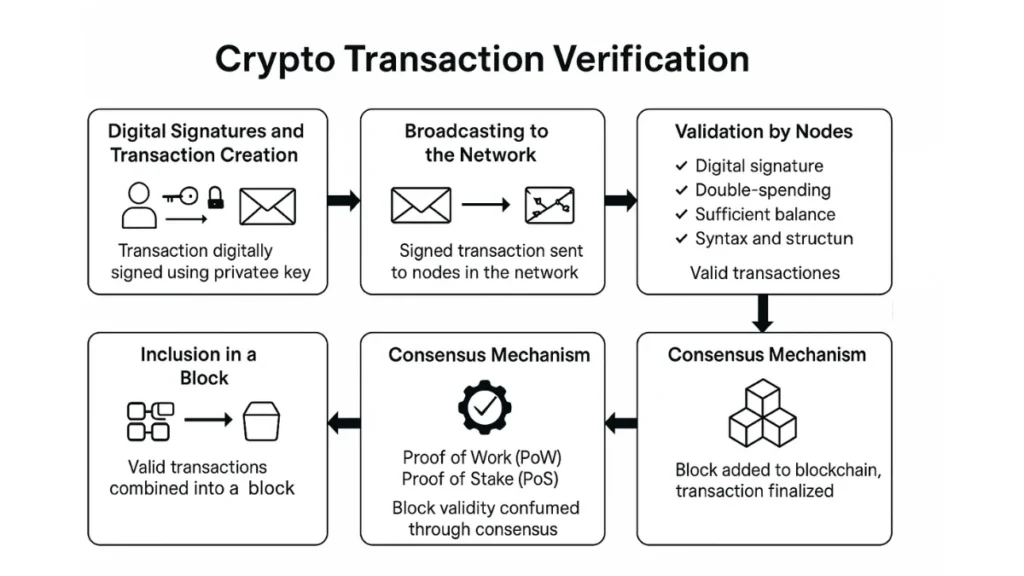Cryptocurrencies have completely changed the way we think about money, trust, and transparency. At the heart of this innovation lies the process of transaction verification, which ensures the legitimacy, security, and immutability of every transaction on the blockchain.

This guide provides a detailed breakdown of how cryptocurrency transactions are verified, the role of consensus mechanisms, common challenges, and how users can independently verify transactions using blockchain explorers.
What Is Transaction Verification in Crypto?
Transaction verification is the process of confirming that a cryptocurrency transfer is legitimate, authorized, and adheres to the network’s rules. Unlike traditional banking systems, where a central authority approves transactions, cryptocurrencies rely on decentralized networks, cryptographic proofs, and consensus algorithms to maintain trust and security.
Key Features of Transaction Verification:
- Decentralization: No single entity controls the verification process.
- Transparency: All transactions are recorded on a public ledger (blockchain).
- Immutability: Once verified, transactions cannot be altered or reversed.
Step-by-Step: How Transactions Are Verified
Each cryptocurrency transaction undergoes a rigorous validation process to prevent fraud and ensure integrity. Here’s how it works:

1. Transaction Initiation and Digital Signatures
A transaction begins when a sender creates and signs it using their private key. This includes:
- Sender and recipient wallet addresses.
- The amount to be transferred.
- A transaction fee (for prioritization).
- A unique digital signature to prove ownership.
2. Broadcasting to the Network
The signed transaction is broadcast to the peer-to-peer (P2P) network and enters a mempool (memory pool), where it awaits validation.
3. Validation by Nodes
Network nodes (computers running the blockchain software) verify the transaction by checking:
- The digital signature matches the sender’s public key.
- The sender has sufficient funds (via Unspent Transaction Outputs, or UTXOs).
- No double-spending (the same funds aren’t used in multiple transactions).
- Proper formatting (e.g., correct nonce, timestamp).
4. Inclusion in a Block
Valid transactions are grouped into a block by miners (Proof of Work) or validators (Proof of Stake).
5. Consensus Mechanism
The network agrees on the block’s validity through a consensus algorithm, such as:
- Proof of Work (PoW): Miners solve cryptographic puzzles (e.g., Bitcoin).
- Proof of Stake (PoS): Validators stake coins to confirm transactions (e.g., Ethereum).
- Delegated PoS (DPoS): Stakeholders vote for delegates to validate (e.g., EOS).
6. Block Confirmation and Finality
Once added to the blockchain, the transaction receives confirmations (additional blocks built on top). More confirmations = higher security.
- Bitcoin: 6 confirmations ≈ secure.
- Ethereum: 30+ confirmations ≈ final.
Consensus Mechanisms at a Glance
| Mechanism | Description | Used By |
|---|---|---|
| Proof of Work | Miners compete to solve puzzles. | Bitcoin, Litecoin |
| Proof of Stake | Validators stake coins to verify transactions. | Ethereum, Cardano |
| Delegated PoS | Stakeholders elect delegates to validate. | EOS, Tron |
| BFT | Nodes vote to agree on transactions. | Stellar, Hyperledger |
| Proof of Authority | Pre-approved validators confirm blocks. | BNB Chain |
Blockchain Security Measures
Cryptocurrency networks employ several security mechanisms:
Digital Signatures
- Ensure only the private key holder can authorize transactions.
Cryptographic Hashing
- Each block contains a unique hash; altering data changes the hash, making tampering obvious.
Double-Spending Prevention
- Nodes check if funds have already been spent before approving transactions.
Immutable Ledger
- Once recorded, transactions cannot be modified or deleted.
How to Verify a Transaction as a User
Users can track transactions using a Transaction ID (TxID) or wallet address via blockchain explorers like:
- Bitcoin: Blockchain.com
- Ethereum: Etherscan
Steps to Verify:
- Locate the TxID in your wallet or exchange.
- Enter the TxID into a blockchain explorer.
- Check details:
- Confirmation count.
- Timestamp.
- Sender/receiver addresses.
- Transaction fee and status.
Tip: If you lose the TxID, search your wallet address to view recent activity.
Common Issues in Transaction Verification
| Issue | Cause | Solution |
|---|---|---|
| Pending Transaction | Low fee or network congestion. | Increase fee or use RBF (Replace-By-Fee). |
| Failed Transaction | Invalid signature or insufficient gas. | Double-check transaction data. |
| Double-Spending | Rare; network checks usually prevent it. | Wait for confirmations. |
| Fork Disputes | Blockchain splits (hard/soft forks). | Follow protocol updates. |
| Censorship | Validators exclude certain transactions. | Use privacy-focused coins. |
Final Thoughts
Transaction verification is the backbone of blockchain trust. By combining cryptographic signatures, decentralized validation, and consensus mechanisms, cryptocurrencies ensure secure, transparent, and irreversible transactions.
Whether you’re a user verifying a payment or an investor analyzing on-chain data, understanding this process empowers you to navigate the crypto world with confidence.
FAQs
1. Can a verified transaction be reversed?
- No. Blockchain transactions are immutable once confirmed and added to the blockchain.
2. How long does transaction verification take?
- It depends on the network:
- Bitcoin: ~10 minutes per block (6 confirmations = ~1 hour for security).
- Ethereum: ~15 seconds per block (30+ confirmations recommended).
3. What happens if I send crypto to the wrong address?
- Transactions are irreversible. Funds can only be recovered if the recipient voluntarily returns them.
4. Are blockchain transactions private?
- They’re pseudonymous—wallet addresses are visible, but identities aren’t linked unless tied to KYC (e.g., exchanges).
5. Why do some transactions fail or stay pending?
- Common causes include:
- Low transaction/gas fees.
- Network congestion.
- Invalid signatures or insufficient funds.
- Fix: Increase fees or resubmit the transaction.
6. What’s the difference between “pending” and “confirmed”?
- Pending: In the mempool, awaiting validation.
- Confirmed: Added to a block. More confirmations = higher security.
7. Can miners or validators censor my transaction?
- Rarely, but possible. Miners may prioritize high-fee transactions.
- Solution: Use privacy coins (e.g., Monero) or adjust fees.
8. How does the network prevent double-spending?
- Nodes check if funds are already spent before validation. Consensus mechanisms (PoW/PoS) ensure only one valid transaction chain exists.
9. Why does Ethereum need 30+ confirmations vs. Bitcoin’s 6?
- Bitcoin: Slower blocks (10 mins) make 6 confirmations secure.
- Ethereum: Faster blocks (~15 sec) need more confirmations to prevent chain reorganizations.
10. What happens to my transaction during a blockchain fork?
- Soft Fork: Your transaction remains valid (backward-compatible).
- Hard Fork: May only be valid on one chain (e.g., ETH vs. ETH Classic). Check which chain your wallet supports.
